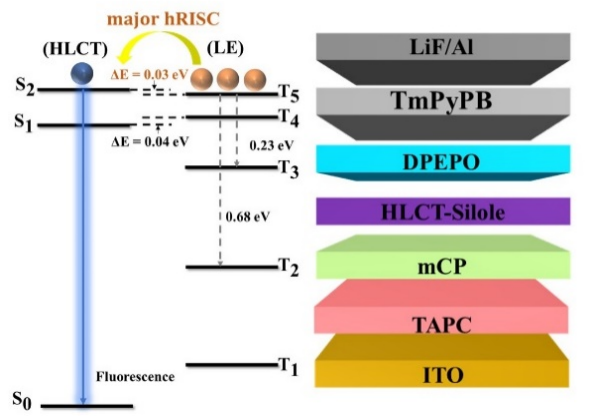
Triplet exciton utilization in solid-state emitting materials has unique advantages in high-performance OLEDs in the area of solid-state lighting and planar displays. Although normal Silole structures have high solid-state photoluminescence quantum yields, there has never been a breakthrough of triplet exciton utilization in silole derivatives, nor a higher device efficiency over 5.8% of silole-based OLEDs over the past decade.
Recently, Prof. Yuanjing Cai from Beijing Advanced Innovation Center for Soft Matter Science and Engineering at Beijing University of Chemical Technology (BAIC-SM at BUCT) has developed a series of silole derivatives Silole-1DPA-TRZ and Silole-1Cz-TRZ as emitting materials with hybridized local and charge-transfer excited states (HLCT) characteristics applied in OLEDs, and achieved a breakthrough in device performance. This special molecular design, for the first time, enables triplet excitons harvest via high-lying reverse intersystem crossing (hRISC) process in silole derivatives, in which Silole-1DPA-TRZ has a more balanced local excitation/charge transfer distribution in the HLCT state along with an efficiency breakthrough of ~ 9.1% EQEmax. This work provides a new perspective on the molecular design of optoelectronic functional HLCT materials of siloles in highly efficient OLED devices.

Fig. 1 (a, b) More balanced distributions of local excited (LE) and charge transfer (CT) states in Silole-1DPA-TRZ; (c, d) nonequivalent hybridization of the LE and CT states in Silole-1Cz-TRZ

Fig. 2 Triplet exciton utilization of efficient HLCT in Silole derivatives and their OLED device structure
This paper entitled “High-lying Triplet Excitons Utilization of Silole Derivatives Enables their Efficiency Breakthrough in OLEDs” has been published in Adv. Funct. Mater. The first author is Liang Zhang, a master student from BAIC-SM at BUCT, and the corresponding authors are Prof. Yuanjing Cai from BAIC-SM at BUCT and Prof. Dongcheng Chen from South China University of Technology. This work was supported by the National Natural Science Foundation of China (52073019), the project of high-end foreign experts from the Ministry of Science and Technology of the People’s Republic of China (G2023106002L), the Beijing Natural Science Foundation (2024 International Scientists Project No. IS24027), and the Guangdong Basic and Applied Basic Research Foundation. We thank all the collaborators for their contributions to this research work.
Article information:
L. Zhang, L. Wang, K. Samedov, M. Chen, D. Chen, Y. Cai, High-Lying Triplet Excitons Utilization of Silole Derivatives Enables their Efficiency Breakthrough in OLEDs. Adv. Funct. Mater. 2024, DOI:10.1002/adfm.202410250.
Article link:
https://onlinelibrary.wiley.com/doi/10.1002/adfm.202410250